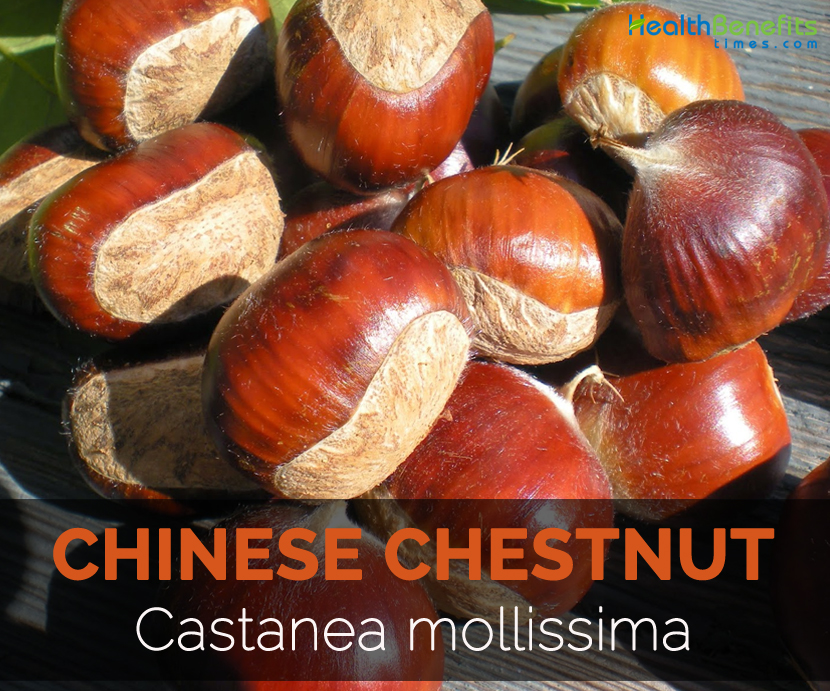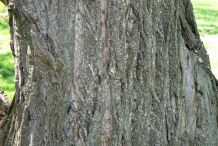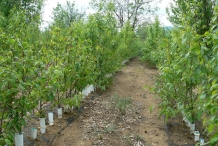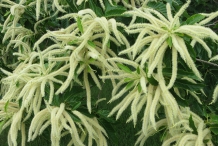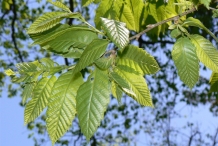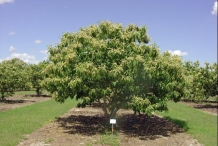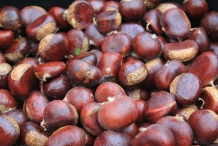Chinese chestnut is the rounded and low branched tree that could reach 40-60′ high. Its leaves are alternately arranged, simple, pinnate, ovate-lanceolate, dark green; 10-30 cm long and 4-10 cm wide. The fragrant, showy flowers are pale yellow or cream in color and 4–20 cm long which appears in June. The shiny brown fruits are spiny cupule which is 4-8 cm in diameter. The fruit has mild, subtle flavor and sweet taste. This plant prefers hot, dry climates and well-drained soils.
Nutritional value
28.35 grams of raw Chinese chestnuts covers 12.46 grams of water, 64 calories, 1.19 grams of protein, 0.31 grams of total fat, 0.47 grams of ash and 13.91 grams of carbohydrate. The same amount offers 19.74% of manganese, 11.44% of copper, 11.33% of Vitamin C, 10.70% of carbohydrate, 8.92% of Vitamin B6, 5.71% of magnesium and 5% of iron.
Health Benefits of Chinese chestnut
Chinese chestnuts assist in the body building, prevent pyorrhea and eliminates the teeth problems. The leaves are used as an aid for fever. Chestnut also provides relief from whooping cough and respiratory ailments. It also prevents the damage and swelling of capillaries and blood vessels.
- Metabolism of Glucose
Manganese helps to regulate the metabolism of glucose in the body. Manganese helps to increase the efficiency of functions and energy. This leads to the low chances of build up as the glucose is utilized properly by the organs and muscles. The adequate amount of manganese helps to aid the diabetes. (1)
- Maintains sugar level
Manganese helps to control the sugar level in the human blood. It prevents the growth of diabetes. Manganese normalizes the secretion and synthesis of insulin and drops in blood sugar are also regulated. This provides the normal life to the diabetic patients. (2)
- PMS syndrome
Women are the sufferers of premenstrual syndrome. Manganese helps to prevent headaches, mood swings, irritability and depression. The supplementation of manganese helps to prevent the PMS symptoms. One should consult the doctor before using the supplementation of manganese to treat PMS because it is related to hormones. (3)
- Treats epilepsy
The deficiency of manganese provokes the epileptic seizures. The supplements of manganese help to control the chances of major or minor epileptic seizure. The study shows that manganese acts as a vasodilator. (4)
- Thyroid function
Manganese is essential for the enzymes and is a vital component of thyroxine. The effective functions of thyroid gland provide assist to treat the health problems in the body such as appetite, weight loss, efficiency of organs and metabolism. (5)
- Treat arthritis
Copper possess an anti-inflammatory properties which helps to reduce the arthritis symptoms. People store the copper in water overnight and drink in the morning which helps to strengthen the muscular system. It helps to become active and provide energy as the metabolism would get an adequate amount of copper. (6)
- Slows the ageing process
Copper is an antioxidant which needs antioxidant enzyme superoxide dismutase to prevent the cells from the free radical damage. Free radicals damage the organs that could lead to age spots, wrinkles, macular degeneration, various cancer and kidney ailments. The adequate intake of copper helps to provide the young looking skin. (7)
- Enhance immunity
Copper plays a vital role in the healing process of wound. It helps to build immunity and cures anemia that helps the body to defend itself and fastens the healing process. It is the cofactor in enzymatic processes that helps in endothelial growth or in the tissue healing process. (8)
- Common cold
Vitamin C promotes the immune power of the body to fight against the colds and coughs. It enhances the iron absorption and strengthens the body against the infection. It also encounters the viruses. (9)
- Skin health
The study shows that the high intake of Vitamin C helps to reduce the appearance of wrinkles, skin dryness and also slows down the ageing process. Vitamin C is essential for the formation of tendons, skin, blood vessels and ligaments. It also assists to heal wound and forms a scar tissue. The evidence shows that the Vitamin C cream reduces the skin redness. The adequate intake of food rich in antioxidants helps to prevent the skin cancer. (10)
https://www.youtube.com/watch?v=nEyrHEMN4Y8
Traditional uses
- The burrs possess tannin and are considered as stomachic and astringent.
- A decoction is used to cure diarrhea, dysentery, nose bleed, profound thirst and regurgitation.
- Flowers are used to treat scrofula.
- The stem bark is useful for poisoned wounds.
- The sap of the stem helps to treat lacquer poisoning.
Precautions
- The plant may irritate the skin or cause an allergic reaction.
- Plant has sharp edges or spines so it should be handled with extreme caution.
How to Eat
- Chestnuts are consumed raw, deep-fried or roasted.
- Chestnuts are dried into flour to make cakes, breads, muffins, soup thickener and polenta.
- Chestnuts can be candied, steamed, boiled, grilled or used in savory or sweet dishes.
- It could be tossed in soups or added to salads.
- The nuts are used to prepare chocolates, pastries, ice cream etc.
- Chinese use chestnuts as snacks.
- They are used in the desserts.
- Chinese chestnuts are added to the lamb and mutton dishes.
- Chestnuts are used on puddings.
- In Japan, it is consumed as steamed chestnut rice.
- In Korea, sweet dessert named yaksik is prepared with jujube fruits, chestnuts, pine nuts which is mixed with glutinous.
- The nuts are used a vital ingredient in poultry stuffing.
- Chinese chestnuts are used to make the chestnut butter–cream.
References:
https://npgsweb.ars-grin.gov/gringlobal/taxonomydetail.aspx?id=9442
https://www.arborday.org/trees/treeguide/TreeDetail.cfm?ItemID=818
http://davesgarden.com/guides/pf/go/82919/
http://www.cabi.org/isc/datasheet/16583
http://www.pfaf.org/user/Plant.aspx?LatinName=Castanea+mollissima
http://tropicalfruitfarm.com.my/pdf/chestnut-k-flower-and-fruit.pdf
http://www.naturalmedicinalherbs.net/herbs/c/castanea-mollissima=chinese-chestnut.php
http://www.starkbros.com/products/nut-trees/chestnut-trees/chinese-chestnut
http://www.gardeningknowhow.com/edible/nut-trees/chinese-chestnuts/chinese-chestnut-trees.htm
http://ecocrop.fao.org/ecocrop/srv/en/cropView?id=4314
http://www.flavorandfortune.com/dataaccess/article.php?ID=471
https://www.uky.edu/Ag/CCD/introsheets/chestnuts.pdf
http://www.nutrition-and-you.com/chestnuts.html
http://www.pingminghealth.com/article/616/chestnuts-and-lower-back-and-leg-pain/
Comments
comments
| Chinese Chestnut Quick Facts | |
|---|---|
| Name: | Chinese Chestnut |
| Scientific Name: | Castanea mollissima |
| Origin | Native to China, Korea and Taiwan. It got introduced in 1853 and 1903. |
| Colors | Shiny brown (Nut) |
| Shapes | Spiny cupule, 4-8 cm diameter (Nut) |
| Taste | Sweet |
| Calories | 64 Kcal./cup |
| Major nutrients | Manganese (19.74%) Copper (11.44%) Vitamin C (11.33%) Carbohydrate (10.70%) Vitamin B6 (8.92%) |
| Health benefits | Metabolism of Glucose, Maintains sugar level, PMS syndrome, Treats epilepsy, Thyroid function |
| More facts about Chinese Chestnut | |
